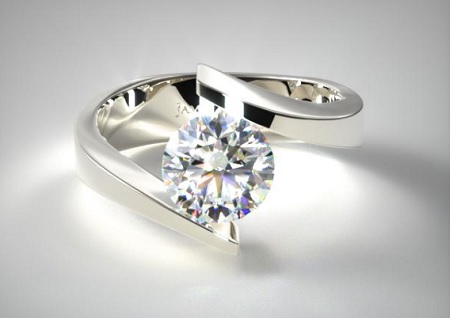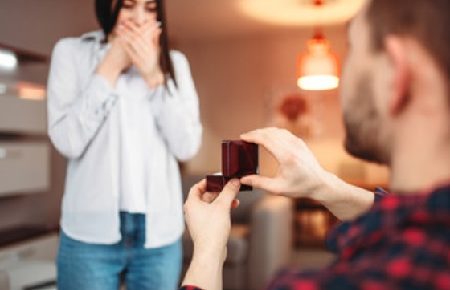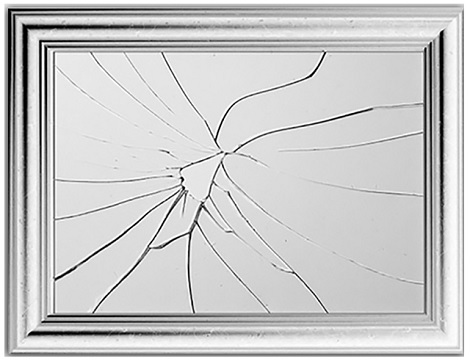Diamond FAQ

Got a question about buying an engagement ring?
Let us take a look at some of the most frequently asked questions in the minds of consumers when shopping for diamonds. This list of questions is compiled to address recurring emails and interactions with Beyond4cs’s readers.
If there’s a question you can’t find answers to, feel free to drop me a message in the comment box or via email. I’ll usually be able to provide you with a response within 24 hours.
Scroll down to see the entire list of commonly asked questions and their answers.
Help! I’ve Set a Budget But Can’t Decide on a Stone
I know it’s a tough one but this is the “million dollar” question nobody else can answer except for you. Within any given budget, there will definitely be a range of diamonds with different kinds of sizes and qualities available. You want to start with the 4Cs and ask yourself whether there are specific requirements you must meet.
Doing so should enable you to narrow down your available choices and help you stay focused in your search. This checklist I made here should be useful as a starting point if you are totally lost. If you are shopping for a fancy cut diamond, then use the checklist here.
That said, I know many people simply go for the largest stone they can find. The problem with this approach is that you might end up with a dull looking diamond if you compromise cut for size.
So, make sure you do your research first before coming to a decision.
How Do I Know If the Price I Am Paying is Fair?
First of all, you need to get educated about the 4Cs and how each quality directly impacts prices. Make sure you read up the necessary information at the various sections on Beyond4Cs.com. Next, shop around. Visit your local stores and browse through the inventory of online vendors like James Allen and White Flash.
Do your own price checks by comparing diamonds with similar qualities (apples to apples).
One common mistake I see people make is when they start sizing up a 1 Carat G color VS2 Excellent cut against a 1 Carat G color VS1 diamond with Very Good cut and automatically assume one to be a better deal than the other. However, this isn’t a fair assessment since the 2 diamonds have different cut properties.
Also, when it comes to diamonds, you get what you pay for. Bargains never exist even if an advertisement screams 90% off. Fair deals do. Going online is the best way to get a bigger bang for buck and get better quality diamonds.
Which are the Most Popular Shapes And Cutting Styles?

In the current market, there are mainly ten types of shapes that rough diamonds are polished into.
Naturally, some have become more popular over the years due to changes in consumer tastes and fashion. Without a doubt, the top seller among the shapes is the full cut round brilliant (57 facets). When cut to ideal proportions, round diamonds offer the best sparkle and light performance compared to any other types of shapes.
Coming in at 2nd place based on popularity is the cushion cut. In the US retail landscape, cushion cut diamonds had overtaken princess cuts with a recent surge in demand. On the other hand, shapes like the triangle cut are considered as rarities and seldom seen in the consumer market, they might still appeal to people looking for exquisite choices.
For people who are looking for something that combines the best features of these top 2 shapes, you might want to take a look at the Asscher cut or the radiant cut.
What Are the “Four C’s”?
Seriously? If you have no idea what they are, I’m not sure what you had been reading on our website so far. Now, pay attention in class! One of the first things you should learn about diamonds is information regarding the four main characteristics. These are cut, color, clarity and carat.
Out of these four, color and clarity denote the material quality of the stone, carat represents the weight of the stone (1 carat = 200 milligrams) and cut represents the only human factor coming into play. The quality of the work that the cutter has put into the given stone determines the luster and beauty of the stone.
Use the menu navigation on the top panel to learn more about each individual aspect.
Is a Certificate or Grading Report Indispensable?

How Much Is Your Diamond Really Worth?
Yes, definitely. Whenever you are shopping for diamonds, one of the first things you should ask your vendor is whether the diamond comes with a certificate. A highly recognized certificate is also useful if you plan to sell your diamond anytime in the future.
Ideally, the grading certificate should be issued by a renowned institute like Gemological Institute of America (GIA) or American Gem Society (AGS).
If you come across diamonds with grading certificates from labs like EGL or IGI, beware. The accuracy of the diamond’s qualities would be way off and the information listed wouldn’t be reliable.
Sometimes, jewelers also provide their own in-house documents or appraisals from a “supposedly” 3rd party neutral grading company. Be very alert and skeptical here. These are simply marketing tactics that unethical jewelers employ to make it seem like they are adding value to your purchase when they are actually not.
How Can You Make Sure a Diamond Is What the Jeweler Say It Is?
Buy only diamonds that are graded by GIA or AGS. Check the laser inscription of the diamond to make sure it tallies with the information on the grading report. You should also loupe the diamond and match inclusions with the clarity plot shown in the certificate.
What are Conflict Diamonds?
Conflict diamonds – or blood diamonds – are diamonds mined in war zones and sold in order to finance the ongoing conflicts in the area.
Nowadays, transparent ethical sourcing policies are adopted by the majority of jewelers and conflict-free diamonds have become a “marketing tool” for many jewelers.
I’m a firm believer in ethical sourcing practices and this is something that should be cheered on and supported unconditionally in the industry. By boycotting the purchase of blood diamonds, we express our protest against using diamonds for violence.
What are Tension Set Rings?

14k white gold spiral tension set ring from James Allen.
Most traditional diamond rings have their feature stone installed in prong settings. Typically, the diamond is placed on top of a basket-like base and the “arms” of the metal are bent towards the stone to hold it in place. On the other hand, tension set diamonds are kept in place by pressure exerted from the ring onto the diamond’s girdle
In tension settings, the feature diamonds are showcased with a minimal amount of metal coverage. With its gravity defying look, such rings usually become the center of attention in social gatherings.
While a tension setting might be a wonderful alternative to solitaire prong setting ring designs, there are some limitations to them too. For example, you might not be able to find a three-stone style tension ring for obvious reasons and a tension setting cannot be resized.
Other Articles & Common Questions Related to Diamond Purchasing
- Are Diamonds Good Investments?
Diamond investing has picked up quite a bit of publicity in the media lately. Are diamonds good investments for financial growth? Would diamonds generate a good return on investment in future? The truth will shock you… - Frequently Asked Questions From Readers Buying Engagement Rings
Over the course of many years in running Beyond4cs.com, I often come across similar questions that readers send me via email. Find out what are the burning questions and concerns that others have and how you can learn from it as well. - Common Scams in the Jewelry Industry And How to Protect Yourself
Like in any other form of businesses, there exist black sheep in the diamond industry which give the trade a bad name. Diamonds are worth a lot of money and nasty people know that. Getting educated is the best way of making sure you don’t fall victim to the tricks of unethical dealers. - Are Diamonds Really Rare?
Many people don’t really know this but the fact is that diamonds aren’t rare at all. It’s true, there is no shortage of diamonds found within Mother Nature’s confines. However, the bulk of the mined diamonds are actually comprised of industrial grade quality stones. Only a small percentage of the mined roughs are considered gem quality and good enough to be used for jewelry purposes. - How to Spot a Fake – Things To Help You Identify One
A common worry that’s at the back of a consumer’s mind is fraud and getting scam into buying a fake diamond. While the best solution is to consult a professional appraiser or gemologist, there are some quick tips you can use to identify a fake diamond yourself. - Marketing And Brandings – What Do They Mean For the Consumer?
The jewelry business is a thriving one where consumers are spending tons of money. With so much competition vying for a share of the pie, how do businesses stand out from each other? Through creative marketing techniques, a branding campaign can help a company portray its uniqueness and stand out of the crowd. - Diamond Knowledge Quiz – Test Your Understanding Here
So, you think you had understand and learnt all you can about diamonds? Are you ready to shop now? Before heading out to make a purchase, try your hand at taking this short little quiz and find out whether you are adequately prepared. - Famous Diamonds – A Treat For Your Eyes
We often see celebrities sporting huge diamond rings and leading glamorous lifestyles. Did you know that some of the finest and rarest diamonds in history also come with interesting heritages behind them? - How Diamonds Are Mined?
Ever wondered how the sparkling diamond on your finger came about? It all begins deep inside the Earth where formation takes place and chaotic eruptions transport the diamonds to the Earth’s surface where they await discovery. Check out this article to get a brief overview of how diamonds are actually mined. - What is the Kimberly Process?
In wake of the controversial blood diamonds saga, the Kimberly Process was designed to help curb the flow of conflict diamonds into the industry. Was it successful? Did it really help change the way diamonds are mined and sold ethically? - How Diamond Prices Are Determined?
The prices of most products we see in everyday life follow a rough formula for business operations. For example, costs to produce, costs to marketing and a certain percentage of markup for the vendor’s profit. However, when it comes to diamond pricing, things aren’t that simple and get complicated due to limited channels of rough diamond supply. - What Are Synthetic Diamonds?
Synthetic diamonds are created in the labs to offer an alternative product to consumers. The thing is, not everyone wants a natural diamond given its bad vibes and reputation with conflict diamonds. On top of that, synthetic diamonds can satisfy the rising demand in other commercial industries where they can improve functionality and performance of electronics applications. - 4 Tips for Selling Your Unwanted Diamonds
Have an old piece of jewelry you no longer need? Looking to sell a diamond ring or get rid of memories associated with a piece of jewelry from a broken relationship? Here are some tips for you to find a diamond buyer near you… - Diamond Origins – The Story Behind the Beautiful Gems
Have you ever wondered how diamonds came about or the journey they take to be transformed from an unpolished state into the brilliant jewel on your hand? Let us take you behind the scenes to find out what happens at the mines and production stages. - The Formation Process of Diamonds
Did you know that every single piece of diamond found on a lucky woman’s hand has millions of years of history to it? Yes, that’s right. Billions of years ago, natural diamonds are formed deep in the ground before any human civilization has its roots on Earth. - Shopping on Amazon? – Let’s Take a Peek Inside
With the advent of modern technology and better connected consumers, buying diamonds online is no longer a thing of the past. One of the largest e-commerce store that everybody is familiar with is Amazon.com. However, is buying diamonds at Amazon a good idea? - Different Types of Diamond Cuts Explained (With Meanings)
Find out the various types of diamond cuts in the market and which are the most popular choices among consumers. We also reveal insider tips to helping you select the best shape to match your recipient’s hand type and finger length. - What is the Rapaport Diamond Report?
The Rapaport Report is basically a price guide for jewelers. Published on a weekly basis, the report helps both merchants and vendors price their diamonds in the market. In this article, we will take a look at other similar services too. - Is the HCA Tool and Score All You Need to Analyze a Diamond?
Well, definitely not. The HCA tool is outdated in today’s environment and serves to confuse more than it helps. Find out why it can be a misleading tool when used incorrectly. - Getting Your Engagement Ring Appraised – Guidelines to Help You Along
Is it important to get your diamond ring appraised? Well, it you intend to get insurance or need a peace of mind on your new purchase, getting a neutral 3rd party expert to offer his/her opinion on your jewelry is important. - Useful Related Sites And Links for Consumers
Compiled and listed here is a list of useful resources for consumers to get more information before making a diamond purchase. Besides direct URLs to leading gemological labs, you can also read up and do further research on diamonds here…
Related Articles
Leave A Comment














12 Comments
Rapaport reported that IGI is as good as GIA. Time to update your site?
You can find the article here: http://www.diamonds.net/News/NewsItem.aspx?ArticleID=43417
That article is based on 10 diamonds only. A sample size that is way too small for any objective and scientific conclusion. And further, if you read the article carefully, which international lab did they use for the tests? There are tons of IGI labs situated around the world. Are they all of the same standards?
I have a rough Diamond which is behaving more than a polished diamond in terms of reflections and refractions.when placed on paper on The table and open The Window in order to allow sun rays on it then when i move slowly The paper side ways i get a white beam in a white dot on The wall The more i move The paper The far white dot move it can move even to more than 6metres .I tried with a pocket torch in a dark room The behaviour is The same.Immersed it in a glass with water The repels and reflect The light and it maintain its colour.I have used two different D tester and also a D scratching test The results is positive or affirmative.I have a vídeo of The same.Would you kindly explain This phenomen?
No. The best (and most accurate) way to affirm it would be to take it to a trained gemologist with proper testing equipment.
Hello expert opinion between these 2
https://www.jamesallen.com/loose-diamonds/round-cut/0.90-carat-i-color-vvs1-clarity-excellent-cut-sku-1963476
Vs
https://www.jamesallen.com/loose-diamonds/round-cut/0.90-carat-h-color-vvs2-clarity-excellent-cut-sku-2045163
This diamond is definitely the better choice in terms of cut quality: https://www.jamesallen.com/loose-diamonds/round-cut/0.90-carat-i-color-vvs1-clarity-excellent-cut-sku-1963476
This is a very tough one. Your insights on which is the better choice would be most enlightening.
http://www.briangavindiamonds.com/diamonds/diamond-details/0.604-e-vs1-round-diamond-bkags-104089113020
http://www.whiteflash.com/loose-diamonds/round-cut-loose-diamond-3735135.htm
I would say both diamonds are on par in quality. Good finds!
If I were to pick a diamond for slightly better value, this would be the one I would prefer: https://www.whiteflash.com/loose-diamonds/round-cut-loose-diamond-3735135.htm
Either way, you can’t go wrong with these 2 stones.
Having bought a size (L) 8 band diamond ring and found that it was to small. So they made me another one in a size (M)
The question I’m asking is? The (M) size diamond ring has now only 7 diamonds and not 8 diamonds. When mention about this to the assistant she told me!! The bigger the size ring the less diamonds they put in it. Is this correct information? Diamond shape brilliant!!
I’m not sure what the terms and conditions for your purchase are. However, the number of diamonds or (ctw) shouldn’t change with the band size unless it is an eternity ring.
Hi, I am looking to purchase a diamond eternity band… I like to get the most bang for the money…. I like to go .25 with 18 diamonds or .20 with 18 diamonds… If I am correct the diamonds are smaller than you would use for a engagement ring can I go to the clarity si1. This would save some money. On the color diamonds would h be ok or it’s best to get the best color and go down on diamond size? Any advice is most grateful ty Lynn
Color and clarity at such small carat sizes is really up to personal preferences (assuming that you trust the vendor to be delivering what is claimed). You wouldn’t see differences in a couple of color grades with smaller diamonds. My advice is to shop at reliable vendors who offer well cut melees because the majority of retailers rip consumers off in this aspect by misrepresenting their products.